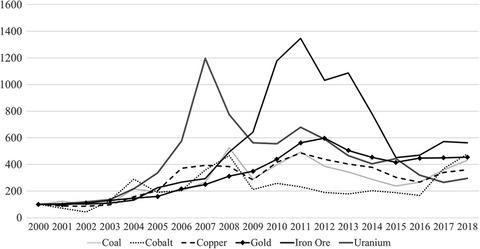Our official English website, www.x-mol.net, welcomes your
feedback! (Note: you will need to create a separate account there.)
Mining in Africa after the supercycle: New directions and geographies
Area ( IF 1.6 ) Pub Date : 2021-04-20 , DOI: 10.1111/area.12723 Andrew Bowman 1 , Tomas Frederiksen 2 , Deborah Fahy Bryceson 1 , John Childs 3 , Emma Gilberthorpe 4 , Susan Newman 5
Area ( IF 1.6 ) Pub Date : 2021-04-20 , DOI: 10.1111/area.12723 Andrew Bowman 1 , Tomas Frederiksen 2 , Deborah Fahy Bryceson 1 , John Childs 3 , Emma Gilberthorpe 4 , Susan Newman 5
Affiliation

|
Mining in Africa is at a pivotal moment. For most of the period 2000 to 2012, the extractive industries were in a “supercycle” of sustained high commodity prices. Driven by resource-intensive growth in emerging market economies, these high commodity prices were anticipated to continue for decades to come. However, this “supercycle” ended in 2012 and there followed a severe slump in mineral prices from 2014 onwards. On the one hand, a new era of commodity market dynamics has begun, with changing patterns of economic activity, minerals governance, and environmental regulation. On the other hand, the end of the supercycle has continued or intensified pre-existing trends towards mechanisation, automation, and enclavity, while distributive pressures on companies by local communities and host nations increase. We argue that the end of the supercycle has reconfigured the geographies of extraction in ways that are not yet reflected in existing research or taken into consideration in policy implementation, particularly around corporate strategy, state–business relations, and models for mineral-based development strategies. In this paper we map the terrain of research on the supercycle in Africa and identify emerging post-supercycle trends – some of which have overtaken research. The paper is structured around examining four themes: (1) new geographies of investment and extraction; (2) new geographies of struggle; (3) national minerals-based development; and (4) labour and livelihoods, for which we identify key trends during the supercycle and post-supercycle and areas for future research and policy development.
中文翻译:

超级周期后的非洲矿业:新方向和新地理
非洲矿业正处于关键时刻。在 2000 年至 2012 年的大部分时间里,采掘业处于商品价格持续高企的“超级周期”中。在新兴市场经济体资源密集型增长的推动下,预计这些高商品价格将持续数十年。然而,这个“超级周期”在 2012 年结束,随后从 2014 年开始,矿产价格大幅下滑。一方面,随着经济活动、矿产治理和环境监管模式的变化,商品市场动态的新时代已经开始。另一方面,超级周期的结束继续或加剧了机械化、自动化和飞地的现有趋势,同时当地社区和东道国对公司的分配压力增加。我们认为,超级周期的结束以现有研究尚未反映或政策实施中尚未考虑的方式重新配置了开采地理,特别是围绕公司战略、国家-企业关系和基于矿产的发展战略模型. 在本文中,我们绘制了非洲超级循环研究的地形图,并确定了新兴的超级循环后趋势——其中一些已经超越了研究。本文围绕四个主题展开:(1)新的投资和开采地理;(二)新的斗争地域;(三)国家矿产开发;(4) 劳动力和生计,我们确定了超级周期和超级周期后的主要趋势以及未来研究和政策制定的领域。
更新日期:2021-04-20
中文翻译:

超级周期后的非洲矿业:新方向和新地理
非洲矿业正处于关键时刻。在 2000 年至 2012 年的大部分时间里,采掘业处于商品价格持续高企的“超级周期”中。在新兴市场经济体资源密集型增长的推动下,预计这些高商品价格将持续数十年。然而,这个“超级周期”在 2012 年结束,随后从 2014 年开始,矿产价格大幅下滑。一方面,随着经济活动、矿产治理和环境监管模式的变化,商品市场动态的新时代已经开始。另一方面,超级周期的结束继续或加剧了机械化、自动化和飞地的现有趋势,同时当地社区和东道国对公司的分配压力增加。我们认为,超级周期的结束以现有研究尚未反映或政策实施中尚未考虑的方式重新配置了开采地理,特别是围绕公司战略、国家-企业关系和基于矿产的发展战略模型. 在本文中,我们绘制了非洲超级循环研究的地形图,并确定了新兴的超级循环后趋势——其中一些已经超越了研究。本文围绕四个主题展开:(1)新的投资和开采地理;(二)新的斗争地域;(三)国家矿产开发;(4) 劳动力和生计,我们确定了超级周期和超级周期后的主要趋势以及未来研究和政策制定的领域。











































 京公网安备 11010802027423号
京公网安备 11010802027423号